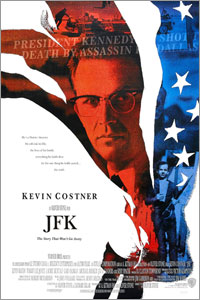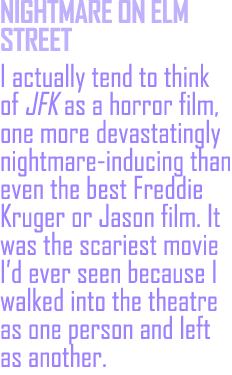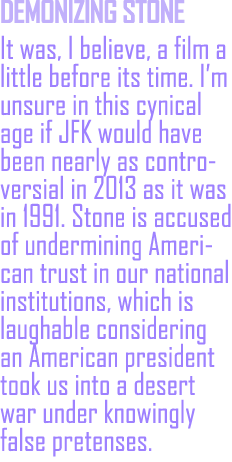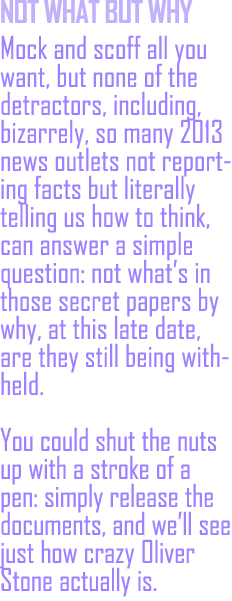
The achievement of the film is not that it answers the mystery of the Kennedy assassination, because it does not, or even that it vindicates Garrison, who is seen here as a man often whistling in the dark. Its achievement is that it tries to marshal the anger which ever since 1963 has been gnawing away on some dark shelf of the national psyche.
óRigger Ebert, Chicago Sun-Times
Quoting everyone from Shakespeare to Hitler to bolster their
arguments, Stone and Sklar present a gripping alternative to the
Warren Commission's conclusion. A marvelously paranoid thriller
featuring a closetful of spies, moles, pro-commies and Cuban
freedom-fighters, the whole thing might have been thought up by
Robert Ludlum.
óRita Kempley, Washington Post
There Are Four Lights
The climax of
Chain of
Command, arguably one of the best episodes of Star Trek:
The Next Generation, features a starving and dehydrated
Captain Jean-Luc Picard ranting at his Cardassian tormentor,
played to disquieting perfection by the wonderful David Warner.
ďThere... are... FOUR... LIGHTS!!Ē Picard shrieks, the otherwise
polished legendary Shakespearean actor Patrick Stewart losing
all dignity and composure as his Captain Picard shrugs off
assistance from Cardassian guards and stumbles out of the
torture chamber. The point of the exercise had been for Gul
Madred to break Picardís will through various renditions
techniques until Picard would begin to deny what his eyes
plainly see--the four lights above Madredís desk. Madred
repeatedly insisted there were five lights. Torture victims,
desperate to end their suffering, would agree to say whatever _
wanted to hear, but that was not enough. Madred insisted his
victims not only say there were five lights, but believe it to
be true.
Convincing people to ignore what their lying eyes tell them is a
time-honored tradition likely as old as mankind itself. Frame
312 of Abraham Zapruderís crude 8 mm film shows the head of U.S.
President John Fitzgerald Kennedy move slightly forward, which
has been used to argue that the fatal head shot was fired from
above and behind the president. But frame 312 is also where
Secret Service Agent William Greer hit the brakes, bringing the
presidentís car to nearly a complete stop, likely reacting to
the sound of gunfire and, per many conspiracists, a bullet
hitting the windshield above the rear-view mirror.
When Robert Groden, author of The Killing of a President, asked for an
explanation, the FBI responded that what Groden thought was a
bullet hole ďoccurred prior to Dallas.Ē A researcher
later found a Ford Motor employee who had helped build a new
windshield for the car, who said he and his co-workers had been
told to destroy the old windshield, which had a bullet hole from
the front. [Wikipedia]
Frame 313 unquestionably portrays the president being struck in
the face by a shot fired from a high-velocity rifle (as opposed
to the medium-velocity Oswald weapon) unquestionably fired from
the front and right of the presidentís motorcade. Eyes are
undoubtedly rolling even as my words are being read, but itís
true. If that image, frozen in time, were of any other person,
during any other incident or attack, a first glance at the image
of a man being struck on the right side of his face, his body
jerking backward, his head snapping to his left, the
interpretation of that image would, 10 out of 10 times, be that
this person was shot from the front.
As much fun as we like to have with Oliver Stone, in the history
of gunshot wounds, it is only and singly this image of U.S.
President John F. Kennedy that we insist depicts a man being
shot from behind and from a high angle, even when the back of
the presidentís head explodes and skull pieces fly out toward
the rear at a straight, flat trajectory. It is the people who
stubbornly refuse to agree this image depicts a rear, high shot
who are branded nuts. There are five lights.
In 1979, the House Select Committee on Assassinations concluded
there were four shots, one coming from the direction of the
grassy knoll.
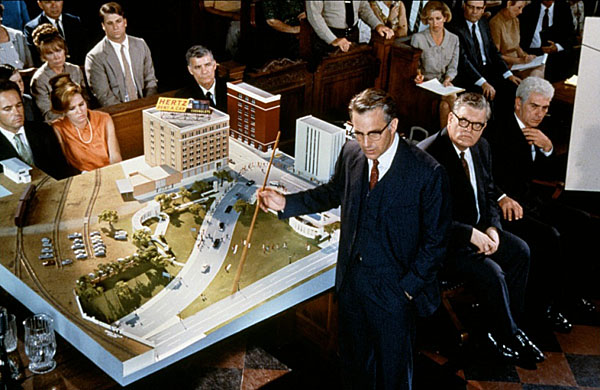
Not Guilty: New Orleans Distrct Attorney Jim Garrison (Costner)'s riveting
(and largely fictionalized) closing argument.
An Alarming Lack Of Objectivity
During this 50th commemoration of the presidentís assassination
it deeply disturbed me to have seen, repeatedly, in mainstream
and cable news, a dismissive hand-wave to conspiracy theories.
Oswald Did It, was the refrain across competing news sources and
networks. Conspiracy Buffs Wear Tin Foil Hats. And, you know,
maybe they do. What disturbed me, however, is it is certainly
not a journalistís duty to tell me what to believe. A
journalistís duty is to report facts and treat me like an adult
capable of reaching my own conclusions. But headline after
headline, over the course of this anniversary, reinforced the
Oswald legend, telling gullible Americans what to think--a job
best lefty to the tabloids.e critical X-Rays and other evidence and
documents related to the assassination is the governmentís
refusal to say, in even oblique terms, why. JFK conspiracy
theories are, in fact, fueled by our own government, by the lack
of why. ďNational Security,Ē isnít a reason. If there were even
the slimmest hint of why these documents are still, 50 years
later, not being made public, Iíd happily pack up my cynicism
and be on my way.
Instead, we get more stonewalling, which only keeps the
conspiracy bandwagon rolling. The chief argument against
conspiracy is the oft-repeated question, ďHow do you manage to
keep so big a secret among so many individuals for so long?Ē The
consistent answer to that question, thanks to the governmentís
stonewalling, is obvious: ďNational Security.Ē You convince
people the nation would be harmed if the truth came out, which
may well have been true in 1963 but is hardly true now. If the
government revealed, for instance, that Castro was behind it
all, does anybody seriously believe the U.S. would now invade
Cuba? And, if the U.S. invaded Cuba now, does anyone seriously
still believe Russia would start World War III over it?
The whole notion is entirely foolish. But, in the 1960ís,
getting people to shut up on the grounds of national security
was a fairly simple thing to orchestrate. ďWe canít let the
truth come out because, if it does, thereíll be a nuclear war.Ē
So they label the e tracheotomy site on the presidentís neck as
an exit wound, pull a swapitty-doo with the body on its way to
Bethesda so the missing scalp and hair have largely been
replaced and the massive exit wound on the back of the
presidentís head now appears to be a rather intact wound of
entry. And so on. And everybody destroys their notes and keeps
their mouths shut. Why? Because they are not cops or reporters,
they are military men and women under orders and the fate of the
nation, if not the world, is at stake.
Or not. But, so long as the government refuses to release those
documents, such refusal suggesting there is contained therein
information harmful to the national interest even at this
advanced age, even this far removed from the old Cold War. Mock
and scoff all you want, but none of the detractors, including,
bizarrely, so many news outlets standing shoulder-to-shoulder
not reporting facts but literally telling us how to think, can
answer a simple question: not whatís in those secret papers by
why, at this late date, are they still being withheld.
You could shut these people up with a stroke of a pen: simply
release the documents, and weíll see just how crazy Oliver Stone
actually is.
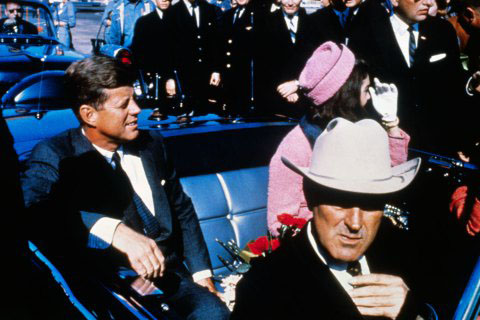 An
American Masterpiece
An
American Masterpiece
Iíve no interest in debating JFK conspiracy theories. If you
want to believe in Oswald and the book depository, be my guest.
But donít try and sell me on frame 313 being anything other than
what it clearly and obviously is: a shot from the front on a
low, flat trajectory consistent with ďBadge Man,Ē the
unidentified and unaccounted-for uniformed cop photographed near
the fence on the so-called ďGrassy Knoll.Ē Iím not saying Badge
Man is real or who or what Badge Man worked for or represented.
Iím saying There Are Four Lights.
Itís easy to brand film director Oliver Stone as a nut. He, in
fact, makes it easy and, so far as I can tell, has made a kind
of franchise business of being one of Americaís most famous
nuts. We cannot, however, dismiss the manís genius. It is
precisely that genius that makes his film work and political
propaganda so wickedly effective and, thus, Stone so much larger
than life that he seems to infuriate, well, everyone.e.
Whether you love it or loathe it, Stoneís 1991 classic, JFK, is
a masterpiece, a tour de force of filmmaking. Critics have
labeled it a propaganda film, and I agree, but that hardly makes
it any less brilliant. JFK is, hands down, my favorite film. I
actually tend to think of it as a horror film, one more
devastatingly nightmare-inducing than even the best Freddie
Kruger or Jason film. It was the scariest movie Iíd ever seen
because I walked into the theatre as one person and left as
another. I walked in thinking and believing one way and walked
out terribly shaken and disturbed. Which is not to say Oswald
was not the lone gunman, sure, okay, frame 313 notwithstanding,
Iím willing to be persuaded. The truth or false of Stoneís film
is rather beside the point. I believe the point of the film was
to raise the question, a question of what really happened fifty
years ago, and to elevate it beyond the cult of conspiracy buffs
and into the public mainstream.
This JFK most certainly did, angering and enraging just enough
people to actually prompt Congress to release more information
about the assassination, though not enough to put any of it into
any better context. Stone himself does not claim his version of
events (actually his versions; JFK doesnít promote a single
conspiracy theory but shines a light on them all) is any truer
than the Warren Commission.
What JFK is, however, is one hell of a movie with superb
performances from the first frame to the last. A procedural
drama that deftly and entertainingly winds its way through the
maze of conspiracy theories and colorfully bizarre characters
the vast majority of the American people, so comfortable with
the Oswald story, arenít even aware of. This movie frightened me
to pieces, not because it was true but because I, like hundreds
of millions of others, really hadnít thought a lot about the
assassination or asked any questions at all about it. Both were
impossible to do after Iíd seen that film, a film that left me
sitting in the theater, left side near the front, shaken and
deeply disturbed while its credits rolled over John Williamsí
deeply moving, somber and disturbing score.
It was, I believe, a film a little before its time. Iím unsure
in this cynical age if JFK would have been nearly as
controversial in 2013 as it was in 1991. Stone is accused of
undermining American trust in our national institutions, which
is laughable considering an American president took us into a
desert war under knowingly false pretenses. Haters tend to miss
the forest for the trees, accusing Stone of manipulating if not
outright brainwashing Americans, when brainwashing Americans is
what Google, Facebook, and virtually all news media and
advertising do twenty-four hours per day. The government lies to
us all the time, donít blame Oliver Stone for that. All of his
critics miss the point of the true power of his brilliant
masterpiece: it changed a nation. It forced an act of Congress.
It got the planet talking about the assassination again. Name me
five other American films in the history of cinema that did
that.

Nuts: Costner and Stone.
JFK II
Stoneís subsequent biopic, Nixon, was flawed only in that it
was, of course, compared to JFK. Nixon was an entirely different
picture, but we ponied up our six bucks expecting JFK II and
walked away disappointed, missing the point that Nixon was an
amazing film. It was so amazing that, after the first fifteen
minutes or so, I actually starting buying Sir Anthony Hopkins as
the 37th president, a man he looked and sounded nothing like,
but one he channeled to sublime perfection. Nixon echoed JFK
only at points that, yes, enraged critics, where Stone
speculated Nixon may have been warned of the assassination in
advance (Nixon was meeting with mysterious Texas oil men and,
apparently, shadows Cuban-types in Dallas the day before. Stone
has him reporting these men to FBI Director J. Edgar Hoover,
whom conspiracists also speculate was aware of some plot against
the president but chose to do nothing). Stoneís Nixon also
battles JFK assassination demons concerning Track II (which may
or may not have evolved into or contained Operation Mongoose, a
planned second invasion of Cuba by displaced Cuban nationals),
an initiative set up under President Dwight D. Eisenhower but
run out of Nixonís office. It is this covert paramilitary squad
(and its mob connections) that haunt Stoneís Nixon throughout
the film, leading to the presidentís idle speculation that it
was this asset, designed to assassinate Castro, which was
somehow turned back on Kennedy--a prevailing conspiracy theory
fueled by the governmentís refusal to release the assassination
documents. Critics scream for Stoneís head over Stoneís
allegation, in Nixon, that the legendary 18-minute gap in the
Nixon Tapes contain those musings over the Kennedy
assassination. Nixon, after all, left far more personally
damaging recordings intact.
I leave open the absolute possibility that Iím just having a
little conspiracy fun, here, and that Lee Harvey Oswald was
indeed a troubled ex-marine whose fifteen minutes of fame as a
local rabble-rouser had been up for some time and who simply
wanted attention and got it by a million-to-one shot from a
bolt-action piece of crap rifle with a misaligned site. For the
record: Iíve fired rifles like that and recycling that thing is
a real pain requiring more time than existed between the second
and third shots at Kennedyís motorcade; and Iím talking just
cycling the weapon, not even aiming. I was not in a speed
contest nor was I as nervous as any gunman taking aim at a U.S.
president undoubtedly would have been. Were I in a contest of
speed rather than a contest of accuracy (ha! With that rifle),
Iíd have chosen another weapon. If youíve never handled a weapon
like this, I understand the average citizenís scoffing,
considering how conditioned we now are with rapid-firing weapons
in movies and on TV. The bolt on these rifles is heavy and has
to be manually lifted, yanked back, and shoved back into its
position, which requires at least a couple of seconds of even
the best marksmen, who would then have to re-set his sighting
because the idiotic bolt-cycling on the rifle completely ruins
his aim.
Itís also possible Rose Mary Woods, President Nixonís secretary,
did exactly what she said she did, and accidentally erased the
Dictaphone belt while transcribing boring chatter about how the
Mets were doing that year. Withholding critical records for no
reason I can think of only gives credence to the Bogeyman
stories.
By the way, Roger Donaldsonís brilliant 13 Days, a
low-budget yakfest about the Cuban Missile Crisis, lends quiet
credence to Stoneís JFK in that it depicts, to whatever level of
accuracy, the prickly relationship Kennedy had with his military
chiefs, including going around them to personal order a young
pilot to lie to them. The bullying
from the joint chiefs, most especially from a tad over-the-top
mustache-twirling Air Force Chief of Staff General Curtis LeMay,
lays grave credibility to Stoneís film. I have no way of knowing if
13 Days is any
more or less true than Stoneís JFK, but the quiet, sad, subtext
of 13 Days is the audience knowing, for a fact, what awaits the
young president beyond the filmís end credits.
Christopher J. Priest
2 December 2013
Home | Blog | Projects | Comics | Rants | Music | Video | Christian Site | Contact
Film Trailer and Stills from JFK
Copyright © 1991 Canal+ / Warner Bros. All Rights Reserved.
Unless Otherwise Noted, Text Copyright © 2013 Lamercie Park. All Rights Reserved.
TOP OF PAGE


